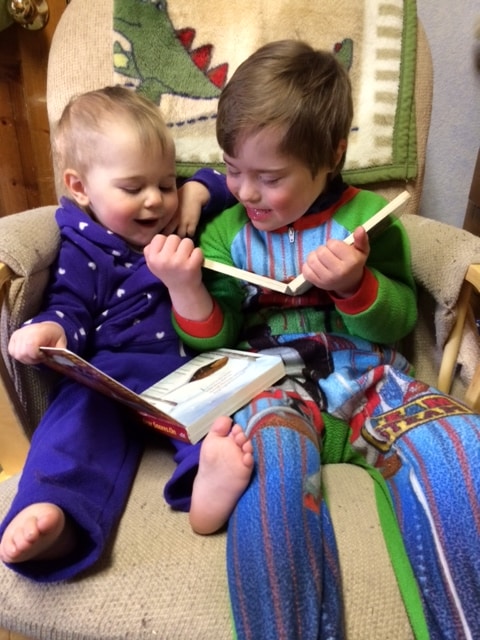DREAMS WITHIN REACH: Parents Teach Reading
Blond heads tilt together. My 5 year old son’s slender arm wraps affectionately around his 6 month old sister’s shoulders. Gently he grasps and moves her hand to stroke a picture in the book and then continues reading to her. Kaleb’s face beams and eyes shine as he shares one of his favorite activities with his infant sister. Kaleb, my 5 year old reader, has Down Syndrome. Kaleb’s reading capabilities surprise some people. He learned his alphabet when he was three. As a five year old, he has 70 sight words in his reading vocabulary. Teaching him to read was not hard, and the resources used are available to anyone. Kaleb has not yet attended a school classroom. He learned to read from us, his parents. In this article, I will share four things that helped in teaching Kaleb to read: quality book time, sign language, books on educating, and therapies.

We, Kaleb’s parents, have been his first teachers. Time spent together teaches him what those he loves most in the world value. Reading books is treasured quality time spent snuggling, laughing, and interacting—a desirable activity even before considering the intellectual rewards. Books were first read to Kaleb after birth during his NICU time. Later, during belly time, books were propped open around him. As he grew older, books filled the time on car rides or flights. His bedtime routine always involved several books. Kaleb has developed a very high level of interest in books and reading.
Sign language enabled us to communicate with and teach reading to Kaleb years before we could have with speech. At 5 years old, we still struggle to understand about 50 percent of words vocalized. However, Kaleb’s 300 word sign language vocabulary communicates clearly with no chance of misunderstanding. Through sign language, I knew Kaleb recognized letters and later words that he read. While reading, Kaleb transitioned from signing to vocalizing words and sentences previously unheard. Signing Time DVDs have been an enjoyable way for both Kaleb and us to learn sign language. We have been very careful however to limit screen time. Kaleb has no exposure to TV in our home and even now watches few other DVDs. (The American Academy of Pediatrics recommends no screen time prior to age 2 and no more than 1-2 hours of screen time per day for older children and teens.)
Resources abound for teaching reading to children. The resource I have most valued is the book, Teaching Reading to Children with Down Syndrome by Patricia Oelwein. I taught Kaleb his first words using the flash cards described in the book. I was creative when needed—tailoring the activities to maintain interest and meaning for him. For example, at first Kaleb did not seem to understand that words represented items. So we propped large words against 3 items on the table each meal, then picked up and pointed to a word each time the item (milk, water, juice) was used. Kaleb delightedly examined the beautiful cardboard words with large red letters. Water, Milk and Juice became his first sight words and opened his eyes to the excitement and meaning of reading words.
Early Speech, Physical, and Occupational therapies have changed Kaleb’s life trajectory in many ways including reading. Infant learning program, school system, and private therapists all contributed a wealth of knowledge, information, and skill to help us. Some therapists’ work during appointments was difficult for nontherapists to replicate. However, instructions for Kaleb’s home program were often simple to follow but with great impact on his development. For example, anytime Kaleb was fed a bottle, a finger was placed under his jaw to prevent tongue thrust which changed how the mouth and speech developed. In every day life—car seats, strollers, baby slings and sleep, we positioned him so that joints and body movements would develop to the full potential. Advice on stimulation of his mind helped us create an intriguing environment for exploration. In unusual circumstances, such as Kaleb’s repeated ICU admissions after heart surgery, therapists guided us to minimize adverse effects and maximize progress toward goals. We live in bush Alaska, in a community accessible only by air. Therapists fly in for the infant learning program and school system up to 4 times per year. To gain more therapy time, we’ve flown Kaleb since birth to Anchorage every 4-6 weeks for private therapies (travel and therapies paid for by TEFRA). Individualized professional advice continues to enable Kaleb to overcome obstacles in his development, learning, and reading.
A friend emailed me a principle taken from St. Thomas Aquinas that I would like to close with. “The slightest knowledge of the greatest things is greater than the greatest knowledge of the slightest things”. The volume of knowledge a child with Down syndrome accommodates can be less than other children. Thus high quality learning for a child with Down syndrome is even more important than for a child without a disability. Reading ranks as a highest quality activity that will open up a child’s world to fun, adventure, and learning. Later, reading will enable the individual to work and live independently. The topics discussed in this article are just a few of the available resources, ideas and guides for parents. A school classroom is not the only way to learn. Parents are effective and powerful teachers of their children.
This story was written by Juliana Montooth published in the Alaska Chapter National Down Syndrome Congress newsletter. Stone Soup Group is republishing the story because we loved it so much!

